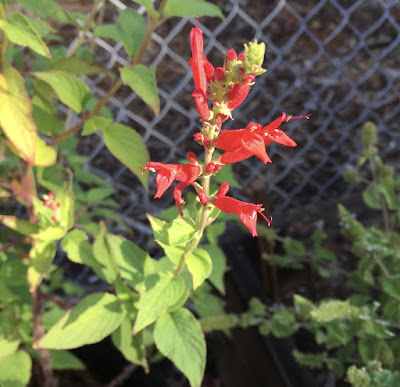
Thinking of bright and delicious blooms on a grey, soggy day

|
|
Pineapple sage (Salvia elegans) can do triple duty in the
garden. Its flowers entice pollinators, add bright beauty and are edible. The leaves also are edible. (Photo: Kathy Morrison) |
Well, we're definitely inside for a few days. It's cold and soggy outside, terrible gardening conditions. And wet soil shouldn't be walked on, anyway -- that compacts it, harming the soil structure and anything that is growing in that soil. And when compacted soil dries, it's more likely to be hard -- and harder to dig.
So, stuck indoors, the gardener can turn to catalogs, gardening guides, magazines, books and online publications that may have been stacking up (ahem!) or bookmarked for further reading. It's the best time all year to tackle that pile.
The Sacramento County master gardeners have dozens of online guides , so I dove into several I'd been meaning to get to. My current favorite, because it sounds so cheerful, is GN 155, Growing Edible Flowers in Your Garden.
I first saw flowers used in food when I was in college, visiting a friend in Oregon. One of her roommates crumbled a couple of marigold blooms into the salad. I was surprised -- this was long before organic gardening was common -- then intrigued. Turns out there are dozens of edible flowers, many of them quite familiar as ornamentals. This means much of the garden can incorporate double- or triple-duty plants: for beauty, food for humans, and food for pollinators and beneficial insects.
It's important to note that any pesticide-treated flower should NOT be eaten. This especially includes systemics, such as those sometimes used on roses.
But growing your own edible flowers means you can be sure they are free from pesticide residue.
While planning the spring garden, consider including some of the flowers listed here. Many more are listed on the aforementioned GN 155, which also notes specific flowers NOT to the eat.
Some pretty and edible flowers
Annuals: Borage (blue petals only); calendula (petals only), nasturtium, petunias, pineapple sage (often a perennial in our climate), radishes, scented geraniums (also a potential perennial; frost-sensitive), signet marigolds, snapdragons, violas.
Perennials: Bee balm, daylily, dianthus, hollyhocks, red clover.
Trees and shrubs: Apple, hibiscus, lilac, rose petals and rose hips, rosemary.
Comments
0 comments have been posted.Sacramento Digs Gardening to your inbox.
Sites We Like
Garden Checklist for week of April 21
This week there’s plenty to keep gardeners busy. With no rain in the immediate forecast, remember to irrigate any new transplants.
* Weed, weed, weed! Get them before they flower and go to seed.
* April is the last chance to plant citrus trees such as dwarf orange, lemon and kumquat. These trees also look good in landscaping and provide fresh fruit in winter.
* Smell orange blossoms? Feed citrus trees with a low dose of balanced fertilizer (such as 10-10-10) during bloom to help set fruit. Keep an eye out for ants.
* Apply slow-release fertilizer to the lawn.
* Thoroughly clean debris from the bottom of outdoor ponds or fountains.
* Spring brings a flush of rapid growth, and that means your garden is really hungry. Feed shrubs and trees with a slow-release fertilizer. Or mulch with a 1-inch layer of compost.
* Azaleas and camellias looking a little yellow? If leaves are turning yellow between the veins, give them a boost with chelated iron.
* Trim dead flowers but not leaves from spring-flowering bulbs such as daffodils and tulips. Those leaves gather energy to create next year's flowers. Also, give the bulbs a fertilizer boost after bloom.
* Pinch chrysanthemums back to 12 inches for fall flowers. Cut old stems to the ground.
* Mulch around plants to conserve moisture and control weeds.
* From seed, plant beans, beets, cantaloupes, carrots, corn, cucumbers, melons, radishes and squash.
* Plant onion sets.
* In the flower garden, plant seeds for asters, cosmos, celosia, marigolds, salvia, sunflowers and zinnias.
* Transplant petunias, zinnias, geraniums and other summer bloomers.
* Plant perennials and dahlia tubers for summer bloom.
* Mid to late April is about the last chance to plant summer bulbs, such as gladiolus and tuberous begonias.
* Transplant lettuce seedlings. Choose varieties that mature quickly such as loose leaf.